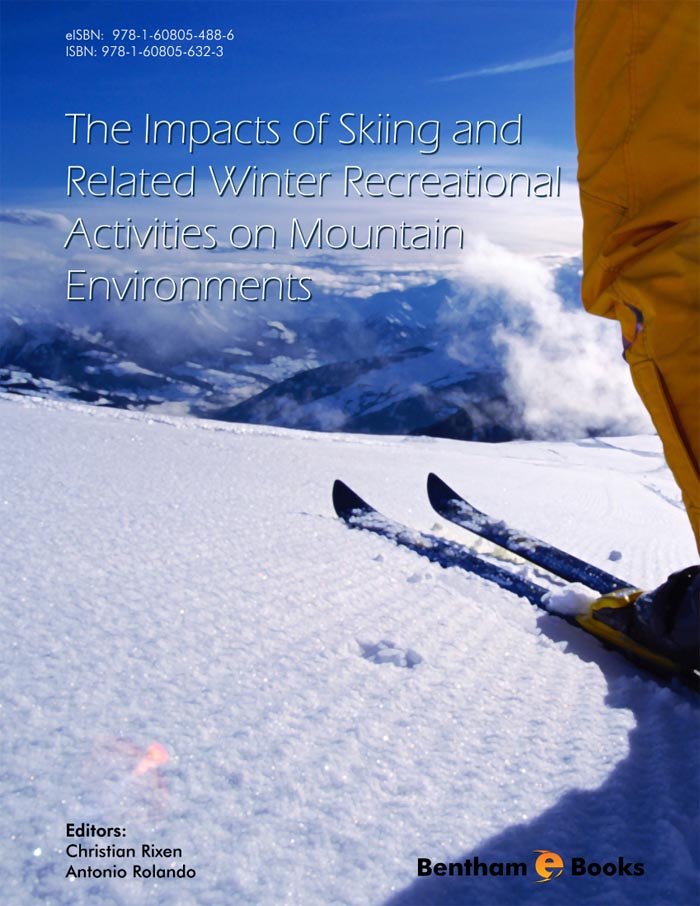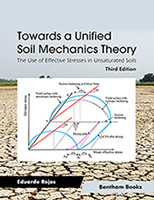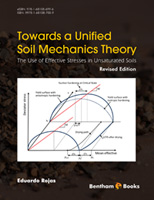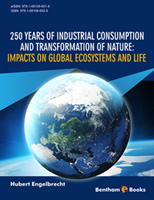At the beginning of 2009, we were considering the possibility of writing an eBook about the impact of skiing on mountain ecosystems. Antonio Rolando had been studying the impacts of ski-pistes on birds and ground-dwelling arthropods since 2003, had experienced the celebration of the XX Olympic Winter Games of Turin in 2006, and had become convinced that the effects of winter sports and tourism on the Alpine environment needed attention. Christian Rixen had been studying the effects of skiing on alpine vegetation since 1999. The option to write an eBook produced by Bentham Publishers provided an ideal opportunity to synthesize the current key research on impacts of skiing on mountain environments. After more than two years of hard work, the eBook is finally realized.
Mountain ecosystems represent one of the last strongholds of natural and semi-natural terrestrial ecosystems. In present-day Europe, in particular, many lowland ecosystems are being transformed at an alarming rate by urbanization or by the intensification of agriculture. Mountain areas are usually less anthropomorphically impacted, but, on the other hand, are also more sensitive to human disturbance, e.g. as caused by winter tourism. The European Alps, with relatively high levels of development and high population density, epitomize the difficulties in reconciling tourism and nature conservation. They are one of the most frequently visited mountain regions of the world. International arrivals are estimated to amount to about 30 million people every year, a little less than 4% of the world’s total human population and almost 7% of that in Europe (CIPRA 2010). Overall, the Alps rank as the second largest tourist destination in the world after the Mediterranean coast. The great number of tourists brings economic benefits to local communities, but can also impact sensitive ecosystems and species, mainly due to the construction of new buildings, access roads and other human installations. Winter sports in general, and the skiing industry in particular, hold a prominent role as an impacting factor because of the large scale changes they cause at the ecosystem and landscape levels. The establishment of ski-pistes for downhill skiing (also referred to as ski runs) involves significant impacts on ecosystems along a broad altitudinal range that can affect both the montane/subalpine and alpine belts (forest and treeless zones, respectively). During ski-piste construction in particular, pastures or forest tracts are often clear-cut or treated with heavy machinery, resulting in considerable ecosystem damage. The increase in free-riding snow-sports away from the prepared ski pistes, although less directly impacting on habitats, can represent a novel threat for wildlife. Attempts to restore disturbed sites are often made, but are not always successful. One of the most pressing issues with winter tourism today is therefore to define and protect the most sensitive natural areas, but also to restore disturbed sites by the best possible means.
The main aim of our eBook is to provide information concerning the global impact of ski-tourism on the soils, vegetation and wildlife of mountain ecosystems to academics, corporate researchers, graduate and under-graduate students and, obviously, policy-makers. Such knowledge is, in fact, the necessary pre-requisite to formulate policies for sustainable development in mountain areas.
This eBook is a truly international product, with contributing authors from many different countries (Austria, Canada, France, Italy, Switzerland and U.S.A.) even though, admittedly, most of the research described herein has been carried out in the European Alps.
The sequence of ten chapters intends to emphasize the ecological importance of mountain habitats, to describe the impact of skiing on soil, vegetation and fauna and, last but not least, to illustrate the state of the art in restoration ecology. The chapters are written either as review papers or as research papers (presenting new data or illustrating the results of previous research).
Chapter one, by Kathy Martin, deals with the ecological value of the mountain environment. She considers North American mountains and warns that, although most alpine habitats appear to have remained relatively intact, ecological change within and adjacent to mountain habitats is occurring rapidly over extensive areas. Alpine ecosystems in North America have experienced large increases in the amount and diversity of human land use, with some areas showing significant deterioration due to recreational activities (such as skiing), livestock grazing, mining, and airborne contaminants. High elevation habitats are vulnerable to erosion, and vegetation recovers slowly after such disturbances. At a landscape scale, developed valley bottoms constitute dispersal barriers for wildlife species with seasonal vertical movements. Since we lack a comprehensive understanding of what is required to maintain ecological processes in alpine habitats, and have limited experience in restoring these sensitive ecosystems, Martin strongly advises the precautionary principle for managing mountain ecosystems. The remaining nine chapters mostly focus on studies carried out in the European Alps, and research carried out in other European (e.g. the Pyrenees) and non-European mountain areas (in North America and Australia) is also described.
Chapter two by Christoph Marty addresses the snow cover and changes in snow reliability in ski areas. A general decrease in snow cover has already been observed in most alpine countries since the 1980’s. Warmer winters have caused a reduction in snow cover at low and medium elevations in ski resorts. However, above 2000 m a.s.l. precipitation usually determines the depth of the snow cover. According to climate projections, the snow reliability will probably decrease further, especially at low elevations, in inner-alpine valleys or on southern slopes. The winter tourism industry has responded to the observed changes in snow cover with technological measures such as snow-making, which presents a new form of pressure on mountain ecosystems (see also chapter four).
Chapter three by Michele Freppaz and collaborators reviews one of the most severe impacts of skiing on alpine terrain: the disturbance of the soil due to skiing and the construction of ski-runs. When ski-runs are created, the rough soil surface is usually leveled with heavy machinery, which perturbs the topsoil and often entirely removes weathered soil horizons. Subsequent problems are soil compaction and reduction of water and air permeability. Restoration through the seeding of plant material is difficult because of a depletion of organic matter in the soil, a reduction of soil aggregate stability and nutrient imbalance. Hence, one of the most crucial challenges in restoration of disturbed sites at high altitudes remains the improvement of the soil organic matter and nutrient status (see also chapters nine and ten).
Chapter four by Christian Rixen summarizes the impacts of skiing-related disturbance on alpine and subalpine vegetation. The main types of disturbance on ski pistes are the construction of ski pistes, snow compaction, and the production of artificial snow. The construction of ski pistes represents the most severe disturbance, especially at high elevations above the treeline, because the entire vegetation and topsoil is often removed (see chapter 3). The compaction of the snow by skiers and snow-grooming machines can induce soil freezing and can physically damage plants. Artificial snow production can change the vegetation composition due to an input of water and ions and because snowmelt is delayed by 2-3 weeks. Although restoration measures have improved considerably in the past decades, full recovery of the vegetation is still not achieved. Restoration measures according to the highest standards (e.g. using locally adapted plant material) need to become standard (see chapters nine and ten).
Chapters five and six were written by Antonio Rolando and his colleagues and take into account the impact of ski-pistes on invertebrates (ground-dwelling arthropods, in particular) and vertebrates (passerine birds and small mammals). Both chapters present the results of previous research (apart from some data on small mammals, that are presented here for the first time) and, taken together, demonstrate that the effect of ski-pistes depends on the animals and habitats considered. For example, forest ski-pistes represent a severe habitat loss for birds, small mammals and brachypterous (i.e. reduced wings or wingless) ground beetles, but, at the same time, they provide a habitat that can be colonized by macropterous ground beetles and spiders. Analogously, forest ski-pistes do not represent an ecological barrier for birds, but they probably are an obstacle to the movements of small mammals. Animal biodiversity of ski-pistes is generally low because of the poor vegetation cover of these anthropogenic linear elements; accordingly, the construction of ski-pistes with less or no vegetation removal would be the simplest way to maintain high levels of animal biodiversity.
Nathalie Buffet and Dumont-Dayot (chapter seven) provide interesting results on the fatal collisions of birds (galliformes) with overhead ski-cables. After having investigated collisions involving six galliform species in the Alps and in the Pyrenees (especially affected are the black grouse Tetrao tetrix in the Alps and the capercaillie Tetrao urogallus in the Pyrenees), they describe and discuss methods to reduce mortality by placing visual devices on the sections of wires where mortality risk is greatest.
Chapter eight, by Raphael Arlettaz and collaborators, focuses on the effects of winter tourism on the black grouse, which they consider as the most emblematic species of alpine biodiversity. The studies of Arlettaz’s team demonstrate that outdoor winter recreation can significantly impact on the physiology, behaviour and demography of wildlife. However, some observations, seem to suggest that the black grouse (and, possibly, wildlife in general) can habituate, if not adapt, to human presence if direct contact with people practicing winter sports is avoided. The recognition of the specific environmental and species-specific preconditions for habituation and adaptation will be a further essential element to increase – e.g. by a set of finely adjusted measures - the tolerance of wildlife towards human presence. If such measures could be adopted in the Alps, the future of the black grouse in ski-developed areas could be brighter than it is currently believed: to some extent, successful human-wildlife coexistence may be mostly a question of fine-tuning of spatio-temporal land use by humans and wildlife. Finally, the authors are confident that the creation of winter refuges, once enforced over wide areas, would deliver beneficial outcomes for the preservation not only of black grouse, but also of other related Alpine wildlife threatened by the rapid expansion of outdoor snow sports.
Brigitte Klug, Berhard Krautzer and collaborators address high-altitude restoration in chapters nine and ten. Brigitte Klug et al. compared vegetation data from restored ski runs between the 1980’s and the 2000’s. She found that modern, regional and locally adapted plant mixtures were better suited to form a sustained vegetation cover on ski pistes than former standard plant and seed mixtures. Bernhard Krautzer and colleagues lay out in chapter ten the basic principles for a sustained ecological restoration of ski runs. A successful restoration at high elevation requires the combination of high quality application techniques and site-specific seed or plant material, containing species that are adapted to the given site conditions. On steep slopes with an inclination between 30% and 45%, additional mulching is necessary to reduce surface drainage and surface soil erosion during the first two vegetation periods. In the long term, only ecologically adapted subalpine and alpine plant species are stable and enduring enough to provide sufficient protection against erosion.
Skiing causes ecological disturbance, a very widespread phenomenon in nature, which may be defined as a discrete event in time that modifies landscapes, ecosystems, communities and population structure, changing the physical environment and the availability of resources. It should be stated that every landscape is shaped, maintained and/or changed by disturbance. Certain organisms may be negatively affected by disturbance, others positively. However, disturbance through skiing seems to exert more negative effects on soil, vegetation and animal communities than natural disturbance. The knowledge and awareness of potential threats of skiing represent an important starting point to develop a more sustainable policy of mountain land-use. Winter tourism is an important way to preserve and sustain human mountain communities, bringing revenue and jobs. The future challenge is therefore that of reconciling human requirements and nature conservation. Human activities are not automatically negative for mountain ecosystems, as sustainable grazing with livestock for thousands of years demonstrates. However, the negative impacts of skiing should be reduced through appropriate mitigation and restoration measures both during and after construction of infrastructures.
Christian Rixen
Swiss Federal Institute for Forest, Snow and Landscape Research WSL, Davos
Flüelastr. 11
7260 Davos
Switzerland
Antonio Rolando
Dipartimento di Scienze della Vita e Biologia dei Sistemi
Turin University
Via Accademia Albertina 13
10123Torino
Italy





